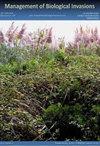氟吡虫胺-苯甲醚处理杂交欧亚水草的田间应用:对本地和入侵水生植物的初步影响
IF 1.2
4区 环境科学与生态学
Q3 BIODIVERSITY CONSERVATION
引用次数: 0
摘要
在北美最广泛和常见的入侵水生植物物种之一是狐尾藻(Myriophyllum spicatum L.)。鉴于其对生态和娱乐价值的各种影响,确定一种有效的处理策略是入侵水生植物管理机构的优先事项。不幸的是,使用除草剂的传统控制措施不仅效果不一,而且还会导致非目标影响。除草剂florpyrauxifen-benzyl(商品名ProcellaCOR®)最近已获得批准,但对其有效性的了解主要局限于中科研究。本研究报告了在劳伦森大湖地区的一个内陆湖中使用氟吡虫胺-苄处理一株杂交水叶藻的结果。处理区的平均丰度在所有采样点都有所下降(或在初始覆盖率为零时保持不变)。两个样方的覆盖率在区域1从50%下降到5%,在区域2从20%下降到0%。在9种本地植物中,处理后出现频率增加(6种)或保持不变(3种)。各样带的平均物种丰富度处理前后均有所增加。在本野外研究中,该品种杂交水千叶藻丰度的大幅下降和本地水生植被的增加提供了初步证据,表明氟吡虫胺苯在该品种杂交水千叶藻的部分湖泊处理中是有效的,施用量为12.68 oz/ac ft,对本地物种的非目标影响有限。我们的研究平衡了观察性研究和后勤管理问题,使研究人员和湖泊利益相关者都受益。研究结果支持最近在“千箔”管理方面取得的进展,这些进展可以改善控制,从而减少“千箔”对生态和娱乐的影响,以及减少非目标影响和长期管理成本。本文章由计算机程序翻译,如有差异,请以英文原文为准。
Field application of florpyrauxifen-benzyl to treat hybrid Eurasian watermilfoil: initial effects on native and invasive aquatic vegetation
One of the most widespread and common invasive aquatic plant species in North America is Myriophyllum spicatum L. (Eurasian watermilfoil). Given the variety of impacts it has on ecological and recreational values, identifying an effective treatment strategy for Eurasian and hybrid watermilfoil is a priority for invasive aquatic plant management agencies. Unfortunately, traditional control efforts using herbicides have not only been variably effective, but they have also resulted in non-target impacts. The herbicide florpyrauxifen-benzyl (trade name ProcellaCOR®) has recently been approved but understanding of effectiveness is mostly limited to mesocosm studies. Our study reports the outcome of using florpyrauxifen-benzyl to treat a strain of hybrid watermilfoil in an inland lake in the Laurentian Great Lakes region. Mean abundance in treatment areas decreased at all points sampled (or stayed the same where initial cover was zero). Percent cover in the two quadrats declined from 50% to 5% in area 1, and 20% to 0% in area 2. Of the nine native plant species present, frequency of occurrence increased (six species) or stayed the same (three species) after treatment. Mean species richness at each transect increased pre-to post-treatment. The substantial decreases in this strain of hybrid watermilfoil abundance and increases in presence of native aquatic vegetation in this field study provide initial evidence that florpyrauxifen-benzyl is effective in partial-lake treatments of this strain of hybrid watermilfoil at an application rate of 12.68 oz/ac ft, with limited non-target impacts to native species. Our study balances observational studies with logistical management concerns to benefit researchers and lake stakeholders, alike. Study outcomes support recent advances in milfoil management that could lead to improved control, which translates to reduced ecological and recreational impacts of milfoil, as well as reduced non-target impacts and long-term management costs.
求助全文
通过发布文献求助,成功后即可免费获取论文全文。
去求助
来源期刊

Management of Biological Invasions
Agricultural and Biological Sciences-Ecology, Evolution, Behavior and Systematics
CiteScore
3.40
自引率
6.70%
发文量
21
审稿时长
16 weeks
期刊介绍:
Management of Biological Invasions, established in 2010 by Dr. Elias Dana, is an open access, peer-reviewed international journal focusing on applied research in biological invasions in aquatic and terrestrial ecosystems from around the world. This journal is devoted to bridging the gap between scientific research and the use of science in decision-making, regulation and management in the area of invasive species introduction and biodiversity conservation.
Managing biological invasions is a crisis science, with Management of Biological Invasions aiming to provide insights to the issues, to document new forms of detection, measurements and analysis, and to document tangible solutions to this problem.
In addition to original research on applied issues, Management of Biological Invasions publishes technical reports on new management technologies of invasive species and also the proceedings of relevant international meetings. As a platform to encourage informed discussion on matters of national and international importance, we publish viewpoint papers that highlight emerging issues, showcase initiatives, and present opinions of leading researchers.
 求助内容:
求助内容: 应助结果提醒方式:
应助结果提醒方式:


